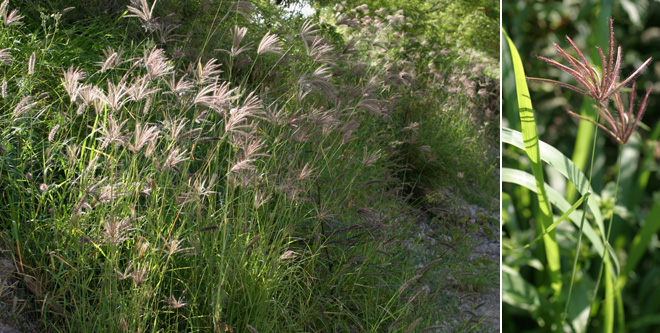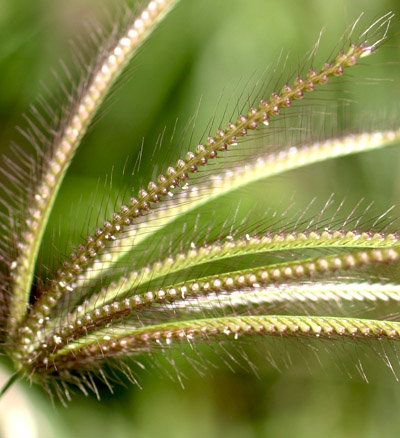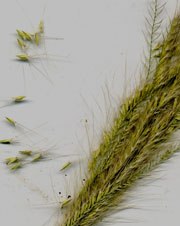|
Tribe Chlorideae
Key to Genus Chloris Sw.
|
|

Grasses of the genus Chloris are sometimes called "fingergrasses" because the spikes are arranged like fingers (digits) at the top of the culm. The spikelets have several common characteristics that usually can be observed without magnification, though magnification certainly helps: the spikelets have awns, typically 1 to 3 per spikelet, and these are usually conspicuous but may require magnification in some species; the spikelets are secund or unilaterial (arranged in pairs on one side of the rachis); the spikelets are attached directly to the rachis or by very short pedicels and fall from the rachis above two glumes of slightly unequal size, so these small, paired bractlets are left behind as the infloresence drops the seeds, providing a ready glimpse of the glumes. The ligule is a short membrane or a dense row of short cilia.
Seven species of Chloris are known to be present in Hawai‘i (Clayton & Snow, 2010; Faccenda, 2023) and many are commonly encountered as weeds in lawns and especially at disturbed sites. Raulerson (2016) lists 3 species on Guam (4 from the Marianas). All Chloris species in Hawai‘i and Guam are naturalized species (that is, none is native) and several are very common in lowland dry locations (Chloris barbata especially; pictured in photo above).
|
|
|
|
[GENUS CHLORIS]
|
|
|
|
|
45a
|
( 49) 49) |
Racemes (spikes) clustered, held upright, typically 2.5 inches (6 cm) or less long, sometimes longer. Floret (first lemma actually) crowned with long hairs (ciliate) and long awns
|
|
[46] |
|
45b
|
|
Racemes spreading or ascending, typically 3 inches (6 cm) or more long, sometimes shorter. Floret with no or only short hairs on lemmas and with or without awns
|
|
[47]
|
|
~~~~ ~~~~~~~~~~~~~~~~~~~~~~~~~
|
|
|
46a
|
(45) |

 Inflorescence of 5-15(-22) spikes. Each spikelet with three long awns (sometimes a 4th, shorter awn). Two sterile florets orbicular, giving the spikelets a beaded appearance on close inspection; each sterile floret awned. Stems and leaves thin, stems with swollen nodes and often a red ring at each node. { Annual, medium size grass forming clumps in dry, disturbed areas, although very widespread in open areas; very common in Hawai‘i and Guam. Swollen fingergrass [HAW - NAT] [FACU]; fingergrass [GUM - NAT]
Inflorescence of 5-15(-22) spikes. Each spikelet with three long awns (sometimes a 4th, shorter awn). Two sterile florets orbicular, giving the spikelets a beaded appearance on close inspection; each sterile floret awned. Stems and leaves thin, stems with swollen nodes and often a red ring at each node. { Annual, medium size grass forming clumps in dry, disturbed areas, although very widespread in open areas; very common in Hawai‘i and Guam. Swollen fingergrass [HAW - NAT] [FACU]; fingergrass [GUM - NAT]
Figure 13B. Close-up of spikes of Chloris barbata
showing beaded appearance of spikelets and
multiple awns.
|
|
|
46b
|
|
Inflorescence of 4-12 feathery spikes. Each spikelet with two long awns (see Fig. 13C below). Two sterile florets not orbicular and only one awned. Lowest lemma with dense tuft of hairs, 2–3 mm long at apex. Panicle branches usually held closely together and erect. { Annual, medium size grass forming clumps in dry, disturbed areas. Feather fingergrass. [HAW - NAT] [FACU]; [?GUM - NAT]
|
|
|
~~~~ ~~~~~~~~~~~~~~~~~~~~~~~~~
|
|
|
47a
|
(45) |
Spikelets with all awns short, the longest about or only a little longer than the length of a spikelet
|
|
[48] |
|
47b
|
|
Spikelet with at least one long awn greater than twice the length of spikelet (0.5 to 1.6 cm long). Inforescence of 5 to 15 ascending or lax racemes
|
|
[49] |
|
~~~~ ~~~~~~~~~~~~~~~~~~~~~~~~~
|
|
|
48a
|
(47) |
Inflorescence of (5-)7-20 ascending or lax spikes. Spikelet with 3 or 4 florets (2-3 sterile) and several short awns, one a very short extension of the strong mid-vein of the 2nd glume. First lemma with a tuft of short hairs. Ligule a short (0.5 mm) membrane accompanied by long hairs across the throat. { Medium-size, somewhat robust, usually erect, perennial grass of open, disturbed areas, verges, and pastures. (See also couplet [44b ]) Rhodes grass [HAW - NAT] [FACU] [GUM - NAT] ]) Rhodes grass [HAW - NAT] [FACU] [GUM - NAT]
Resembles the much coarser Eleusine indica, the latter with 6 or fewer racemes and spikelets 5 mm or more in length.
|
|
|
48b
|
|
Inflorescence of 4-13 widely spreading spikes. Spikelets with but one sterile floret.
|
|
[50] |
|
~~~~ ~~~~~~~~~~~~~~~~~~~~~~~~~
|
|
|
49a
|
(47) |
Panicle branches (racemes) 5–15 between 5 and 8 cm long, ascending or somewhat lax, in 2–4 whorls. Spikelet narrow, acute, light green or yellow, with two obvious awns, at least one awn approaching 3/8 in (1 cm) in length. Glumes similar, but one clearly shorter than florets. Ligule membranous, short ciliate { Medium-size, loosly-tufted annual in mostly mesic, disturbed sites, verges, and fields. Radiate fingergrass [HAW - NAT] [FACU]; plush-grass [GUM - NAT]
|
|
|
49b
|
|
Racemes between 5 and 23 cm long, spreading (outward to downward radiating). Spikelet wedge-shaped, dark brown or black. Sterile floret truncate. Glumes about equal in length to florets. Tip of leaves blunt. { Perennial, with stolons. Windmill grass (see also couplet [50b]) [HAW - NAT]
|
|
|
~~~~ ~~~~~~~~~~~~~~~~~~~~~~~~~
|
|
|
50a
|
(48)
&
( 45) 45) |
Spikelet narrowing towards tip (accuminate), light green to tan in color. Spikes 1.5 to 8 in (4 to 20 cm) long radiating from common point(s) on the culm in one or more whorls .. .
|
|
[51] |
|
50b
|
|
Spikelet blunted at tip (wedge-shaped or cuneate), dark brown or black in color. Inflorescence of 5 to 15 spikes (or racemes with short pedicels) radiating from a common point on the culm and radiating outward, each spike between 5 and 23 cm long. Tip of leaves blunt. Windmill grass (see also couplet [49b]) [HAW - NAT]
|
|
|
~~~~ ~~~~~~~~~~~~~~~~~~~~~~~~~
|
|
|
51a
|
(50) |
 First sterile lemma >1 mm long, bilobed for ¼–½ its length. Panicle with 3–9 widely speading racemes in a signle whorl (rarely with a separate raceme arising below the whorl). { Fairly common, small, perennial speading grass with widely spreading racemes; resembling Bermuda grass. The varieties divaricata and cynodontoides are no longer recognized as distinct in Hawai‘i. Stargrass [HAW - NAT]
First sterile lemma >1 mm long, bilobed for ¼–½ its length. Panicle with 3–9 widely speading racemes in a signle whorl (rarely with a separate raceme arising below the whorl). { Fairly common, small, perennial speading grass with widely spreading racemes; resembling Bermuda grass. The varieties divaricata and cynodontoides are no longer recognized as distinct in Hawai‘i. Stargrass [HAW - NAT] Chloris divaricata R. Br.
|
|
|
|
51b
|
|
First sterile lemma minute, <0.7 mm, scarcely bilobed. Inflorescence of 3–12 branches in one or two whorls. { Rare. Specimens with but a single whorl cannot be distinguished from C. divaricata without close examination of the first sterile lemma, which is as described for C. radiata, as well. [HAW - NAT]
|
|
|
|
|
Species of Chloris included under a more recent name (=new name):
|
|
C. inflata Link [GUM] (= C. barbata)
|
|
|
|
CHLORIS PHOTOS
[CLICK ON THUMBNAIL TO OPEN AN ENLARGED IMAGE]
|
|

|
|
|
Fig. 13C. Dried flower head
of Chloris virgata illustrating
several diagnostic characteristics:
spikelets with two awns and
a crown of stiff hairs; spikelets
falling from rachis leaving
glumes (one short and one long)
still attached to rachis.
|
|
|